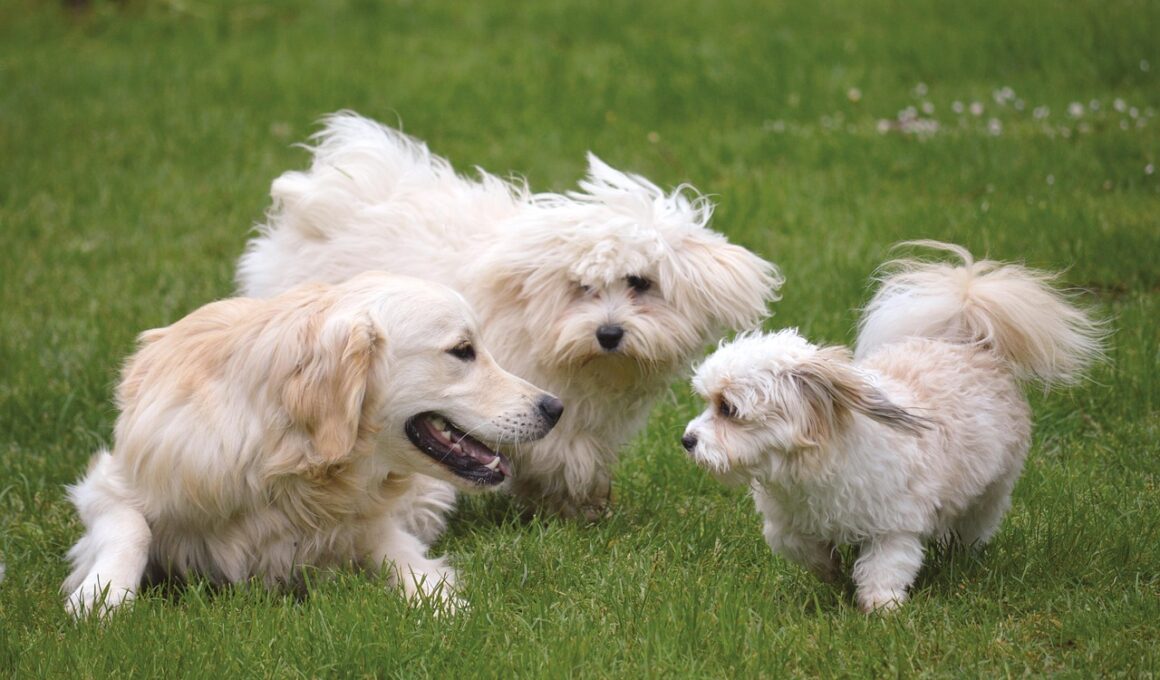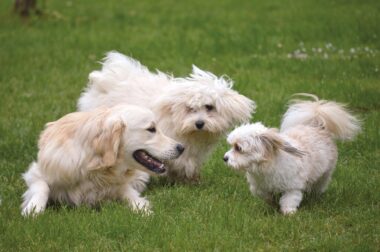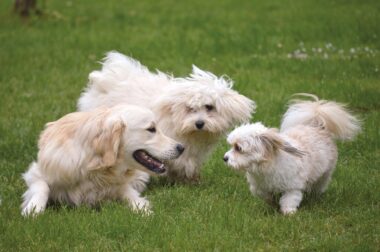Socializing Your Dog: Dos and Don’ts
Introducing your new dog to socialization is crucial for a well-adjusted pet. Start by establishing a safe environment where your dog feels comfortable. This typically includes your home and gradually progresses to outdoor settings. Remember, the key is patience. Begin with short interactions with other dogs and humans, allowing your pup to dictate the pace. The initial experiences should be positive and devoid of stress. Keep outings frequent, enabling your dog to become accustomed to various situations such as parks, busy streets, and other pets. Training sessions can also help instill confidence. Consider enrolling in local puppy socialization classes. These classes provide controlled environments where puppies can interact under supervision. It’s essential to pay attention to your dog’s body language during these interactions, as signs of fear or aggression may indicate a need for a break. Avoid overwhelming your canine companion at the start, as it may foster anxiety over time. Gradual exposure is key to helping your dog learn how to behave appropriately in different social situations. Above all, consistency in training will yield the best long-term results for a balanced, social pet.
Now that you’ve introduced your dog to the basics, let’s discuss some effective dos and don’ts. Do reward your dog with treats or praise when they exhibit positive behavior, such as playing nicely with another dog. This reinforces good behavior. Additionally, remember to keep your own energy levels calm and assertive. Dogs are sensitive to their owner’s emotions and body language. A relaxed demeanor will likely influence your dog’s behavior positively. Don’t rush the process and avoid forcing interactions that may provoke stress or fear. Pushing your dog too far too fast can lead to lasting apprehension away from home. Always observe your dog’s reactions and trust their instincts. Do ensure varied socialization by exposing your dog to different people, animals, and environments. This will grow their confidence and adaptability. Regular outings with fellow dog owners can help develop friendships between your pets while also providing a space for corrective training if needed. Don’t forget to offer plenty of breaks during long social events to prevent overstimulation, as healthy pacing is critical for successful socialization and happy experiences.
Building Positive Experiences
When socializing your new dog, focus on building positive experiences. Always remember that the aim is to create a friendly association with new encounters. Do let your dog approach at their pace rather than forcing interactions, as this will foster trust and confidence. If you see your dog becoming anxious, use calming techniques, such as reducing distance or treating distractions. Allow your dog to explore their new surroundings at their own pace, and lead them confidently through different experiences. Creating enjoyable memories during these early months sets the foundation for future socialization. For instance, visiting pet-friendly establishments can expose your dog to numerous sounds, smells, and sights that will contribute to their growth. Don’t forget to take note of your pet’s preferences; some dogs thrive in bustling environments, while others prefer quieter settings. Regularly changing your socialization activities will prevent your dog from becoming bored, allowing for more effective learning. Seek out local dog meetups or activities designed specifically for socializing pets and improving behaviors. Overall, helping your dog associate positive feelings with various interactions will ensure a well-socialized companion.
In addition to meeting other dogs and people, your dog should experience diverse environments. Do take your furry friend to different surroundings like parks, beaches, and street cafes. The more secure your dog feels in varied environments, the more comfortable they will be long-term. Ensure that the new experiences are enjoyable and conducted at a pace your dog is comfortable with. However, don’t overlook the importance of routine. Try to maintain a consistent schedule of social outings to cultivate social skills. Added predictability in their lifestyle will contribute to their confidence. When on walks, let your dog meet other controlled and friendly pets, ensuring you monitor these encounters closely. If you notice reactive behavior in your dog, redirect their attention towards you with a reward. Remember to take steps to protect your dog from overly rambunctious playmates that may overwhelm them. Engaging in activities like obedience classes can also be beneficial. These can serve to reinforce commands while providing structured socialization opportunities. Above all, consistency, observation, and encouragement are vital in crafting well-mannered social interactions for your beloved pet.
Understanding Your Dog’s Signals
In the process of socializing your dog, it’s vital to understand their signals. Learning to read your dog’s body language will help you gauge their comfort level. Do recognize signs that indicate fear or stress, such as lowered tails or tucked ears. Responsively addressing your dog’s fears can prevent potential behavioral issues down the line. If you notice uncomfortable behavior, gently remove your dog from the situation and seek a calmer environment. Sometimes, comfort can come from a brief moment of solitude or a favorite toy. It’s also perfectly alright to acknowledge when your pup seems overwhelmed. Don’t force them to interact; this could create adverse experiences. Instead, allow them to dictate where their comfort lies and proceed accordingly. As they grow more confident in their surroundings, you’ll witness gradual improvements in their willingness to engage. Establishing trust is paramount during socialization. Include positive reinforcement during inappropriate behavioral attempts to ensure correct responses. Your guiding presence will teach your dog to face their fears gradually, making future social encounters less stressful.
Another critical element to focus on is tailoring socialization to your dog’s existing temperament. The dos include being savvy about the personality traits of various breeds and adjusting your socialization approach accordingly. Understanding the innate tendencies of your dog can entail research about their breed and background. If you’ve adopted a rescue, sometimes reaching out to previous owners can reveal invaluable insights. By knowing your dog’s predispositions, you can avoid overwhelming situations that could hinder their growth. However, don’t assign limitations about what your dog can experience based solely on breed stereotypes. Dogs, just like people, are unique. Each dog has its own likes, dislikes, and behavioral inclinations. Encourage exploration within reason, recognizing their limits without stifling their development. Do seek help from professional trainers if you face challenges; they can offer individualized strategies for socializing your specific dog. Ultimately, matching the socialization process to your dog’s personality promotes a happier and more adaptable companion, fostering stronger bonds between you and your furry friend.
Long-Term Socialization Strategies
The journey of socializing your dog doesn’t conclude after a few outings; it’s an ongoing endeavor. Do incorporate socialization into your regular routine to strengthen their experiences continually. Attending events, dog parks, or group training sessions weekly will yield cumulative benefits. Aim to expose your dog to specific events, such as parades or open-air markets, fostering even greater adaptability. Be sure also to socialize not just with other pets but with diverse types of people. Children, seniors, and individuals in various attires can help broaden your dog’s exposure. This proactive approach bolsters their confidence by encouraging familiarity. Regularly incorporating training, whether through obedience classes or agility courses, is also key as this builds skills while reinforcing social engagement. Don’t solely depend on singular events; prioritize frequent interactions to promote emotional security. Remember that socialization can be a gradual and recurring experience, continually creating opportunities for your pup to embrace and overcome challenges along the way. All these strategies contribute to a well-rounded, socially adept dog for years to come, enhancing both your lives.
In conclusion, remember that socializing your new dog is a journey that requires time and dedication. Do provide a supportive environment where they can grow, learn, and adapt. Maintaining positive encounters reinforces their self-esteem and promotes good behavior within various social contexts. Throughout this process, the connection formed between you and your dog deepens, fostering mutual understanding. Don’t hesitate to reach out for support from trainers or behaviorists if challenges arise, as professional guidance can make a world of difference. Cultivating a well-socialized dog not only benefits the pet but enriches the lives of those around them. Embrace every interaction as an opportunity for growth, love, and friendship. Ultimately, the goal of socializing your new dog is to pave the way for a confident, adaptable companion, enriching both their life and yours. Cherish the journey and take pride in your role as a loving guide, steering your furry friend into life’s adventures. With consistency, patience, and lots of affection, your efforts to socialize your dog will surely yield positive results, leading to wonderful experiences together in the future.





